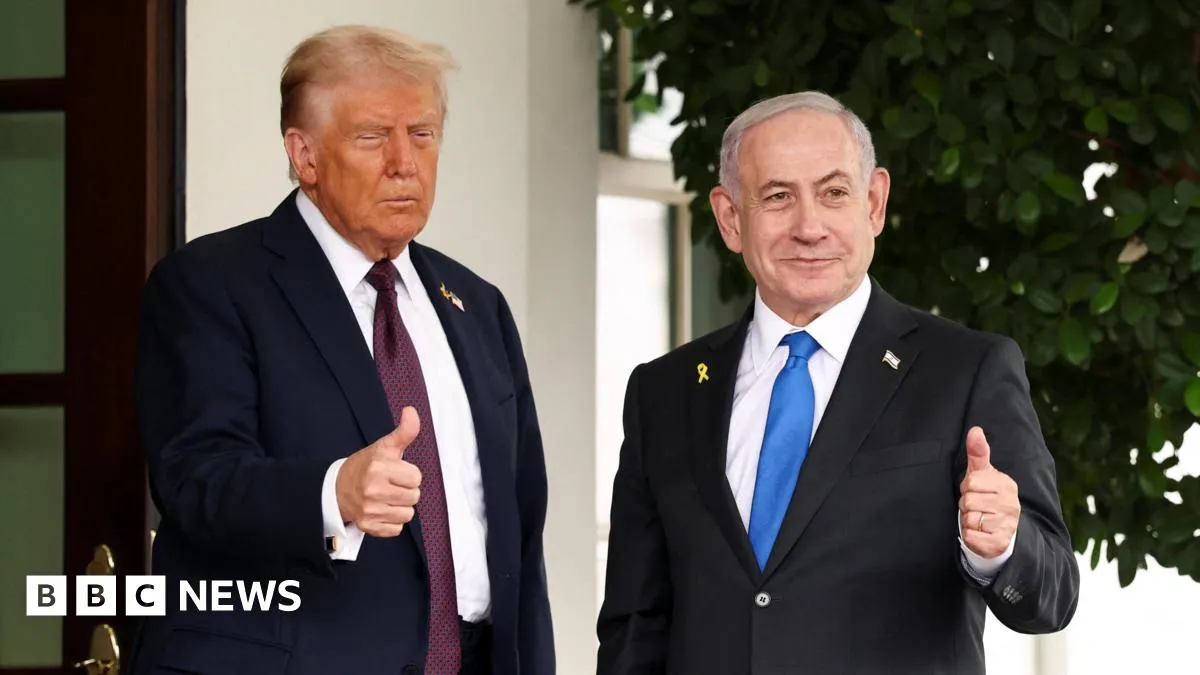
The White House was bustling with activity as Israeli Prime Minister Benjamin Netanyahu made his fourth visit to Washington this year, a record for any foreign leader. Netanyahu's trips included significant discussions on trade and tariffs during his visits in February and April, followed by a July meeting shortly after joint strikes on Iranian nuclear facilities by Israel and the US.
During this meeting, President Donald Trump and Netanyahu are set to discuss a new 21-point peace plan aimed at ending the ongoing conflict in Gaza. Their discussions are taking place in the Oval Office, which is currently closed to the press. A lunch meeting is scheduled for 12:00 local time (17:00 BST), followed by a joint press conference at 13:15 local time, where both leaders are expected to address the media.
Trump's special envoy to the Middle East, Steve Witkoff, has emphasized that the US has developed a comprehensive 21-point peace plan. Although the specifics are not fully disclosed, media reports suggest that the proposal may outline a pathway to a future Palestinian state. This is particularly significant given Netanyahu's recent rejection of statehood in his address to the UN. The plan reportedly allows Palestinians to remain in the Gaza Strip, shifting the focus from displacement to stabilization.
Among the key components of the peace plan, as reported by The Times of Israel, is a commitment for Hamas to disarm and the complete demilitarization of Gaza. Furthermore, the plan aims to establish a process for de-radicalizing the local population. Achieving consensus will likely require substantial concessions from both Hamas and the Israeli government, which may lead to challenges in the negotiations.
Security measures have been intensified at the White House in preparation for Netanyahu's visit. Black fencing has been erected, and trucks are blocking Pennsylvania Avenue. These precautions indicate a heightened risk of protests, and indeed, small demonstrations against Netanyahu have already occurred in the vicinity.
In anticipation of the meeting, the briefing room is filling up with reporters eager to cover the discussions between Trump and Netanyahu. As the two leaders meet behind closed doors, the focus will likely be on the proposed peace plan. The upcoming press conference at 13:15 local time (18:15 BST) will provide an opportunity to hear their perspectives on the negotiations.
White House Press Secretary Karoline Leavitt has voiced optimism regarding the peace plan, noting that both Israel and Hamas may need to make compromises that could leave them dissatisfied. “To reach a reasonable deal for both sides, both sides have to give up a little bit,” Leavitt stated, emphasizing the need for collaborative efforts to conclude the ongoing conflict.
Netanyahu has reiterated that no deal has been finalized, while Hamas maintains they have not received the US proposal in any formal capacity. This uncertainty casts a shadow over the discussions as expectations rise.
Trump has expressed a strong belief in the potential for achieving greatness in the Middle East, sharing a message on social media that highlights the importance of the current negotiations. He described the discussions with Middle Eastern leaders as “very inspired and productive,” indicating a sense of urgency and optimism surrounding the peace efforts.
Despite past statements of optimism about ending the conflict, the 21-point plan, devised by Witkoff, remains a framework that requires detailed negotiation. The proposal aims to integrate ideas from various international stakeholders, including former UK Prime Minister Sir Tony Blair. However, Israel's objections to provisions for Palestinian self-governance and Hamas's concerns over disarmament could complicate the discussions ahead.
Reports suggest that the proposed plan includes the release of all hostages within 48 hours of the deal's confirmation. Following this, Israel is expected to release hundreds of Palestinian prisoners serving life sentences. Additionally, Hamas members who agree to peace will be granted amnesty and safe passage out of Gaza, with a stipulation that the group will not have a future role in governing the territory.
As the situation evolves, it is evident that the proposed framework signifies a shift in the Trump administration’s approach, moving away from previous strategies that advocated relocating Gaza's entire population. Instead, the latest proposal encourages Palestinians to remain in Gaza while acknowledging their aspirations for statehood and the need for reform within the Palestinian Authority.